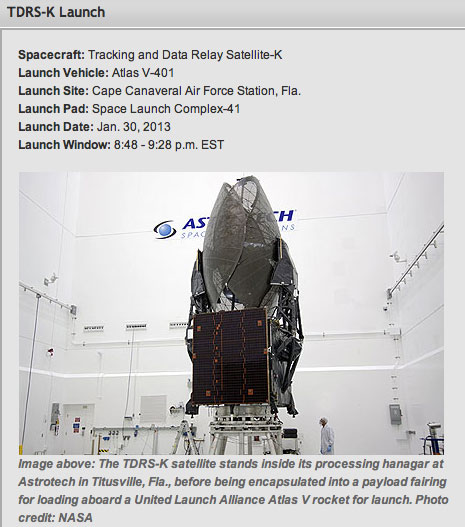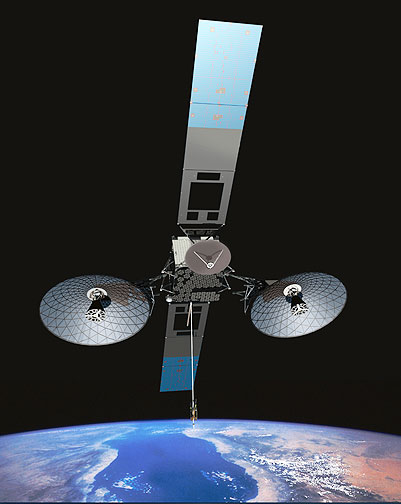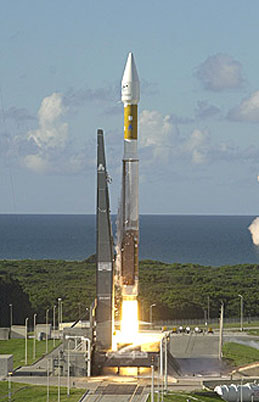
[SatNews] The one-day delay allows technicians additional time to replace an Ordnance Remote Control Assembly (ORCA)
Cape Canaveral Air Force Station, Florida (January 23, 2013) – The launch of a United Launch Alliance Atlas V carrying NASA’s Tracking and Data Relay Satellite (TDRS-K) mission is being rescheduled to January 30 at 8:48 p.m. at the opening of a 40-minute launch window. The one-day delay allows technicians additional time to replace an Ordnance Remote Control Assembly (ORCA) that demonstrated an anomalous signal prior to planned ordnance connections. The vehicle rollout to Space Launch Complex-41 will now occur January 29 in preparation for launch.
The standard Launch Readiness Review is scheduled for Monday, January 28. At the conclusion of this review, the go is given for the Atlas V rollout to the launch pad. The prelaunch news conference will then be held at 1 p.m. Rollout is targeted for 10 a.m. on Tuesday, January 29.
Launch coverage on NASA Television and the Web will begin at 6:15 p.m. on January 30.
As a vital information pipeline for space-based research and exploration ambitions, the TDRS constellation fulfills NASA's broadest communication demands. Now into it's fourth operational decade, the TDRS legacy continues to be communications excellence. The addition of the third generation of spacecraft will replenish the constellation and ensure that the critical lifeline of space-to-ground communication support will be available for many years to come.
The launch team members assemble at their computers and communication consoles about three to four hours before launch.

The NASA launch manager is the highest authority during the countdown and provides NASA's "go/no-go" decision to the mission director.

Image to right: An Atlas V lifts off from Launch Complex 41 at Cape Canaveral Aug. 21, 2002 carrying the HOT BIRD 6 broadcast satellite. Image credit: International Launch Services
Before liftoff, the launch manager checks with the launch team to make sure all the criteria are met and that the payload and rocket are ready to go.
Tim Dunn, NASA Launch Manager (NLM) The launch manager ensures that the countdown and launch decision processes are properly followed. The launch manager polls the launch team before passing along a "go/no-go" decision to the mission director.
James Wood, NASA Chief Engineer (NASA CE) The chief engineer is responsible for advising the launch manager of the launch vehicle's engineering and analysis status for launch.
Diana Menant Calero, Mission Manager (NASA MM) The mission manager assesses the launch service and spacecraft readiness ahead of launch.
Jeff Gramling, Project Manager (Goddard Space Flight Center, Maryland.) The project manager oversees development of the spacecraft and its operation once in space. On launch day, it's up to the project manager to declare that the spacecraft is ready to carry out its mission.
Rick Boutin, Safety and Mission Assurance Manager (SMA) The Safety and Mission Assurance Manager monitors NASA safety and mission assurance requirements during the launch countdown. The SMA also makes sure the countdown is conducted properly and serves as the integrator of the launch vehicle.
Joe Lackovich, NASA Advisory Manager (NAM) The advisory manager provides consultation for assessing the launch process and countdown.
Atlas rockets have evolved over four decades to become a highly reliable launch vehicle. The Atlas V booster family now provides a variety of vehicles capable of launching a wide range of spacecraft and satellites.
The Centaur upper stage uses pressure-stabilized propellant tank design for efficiency. Centaur engines can start and re-start multiple times in space, enabling insertion of a spacecraft into a low Earth parking orbit, followed by a coast period and finally, insertion into geosynchronous transfer orbit. They're also capable of direct insertion into an inter-planetary trajectory.

